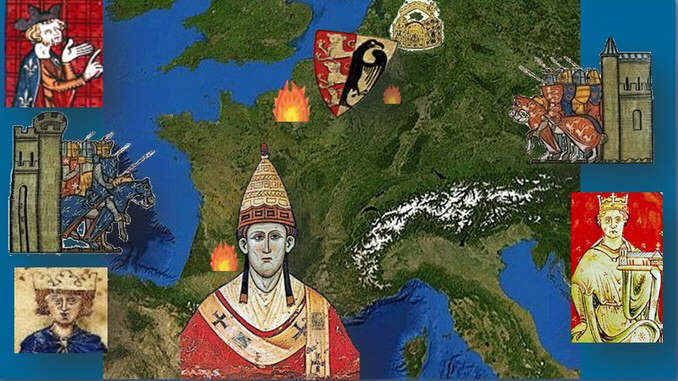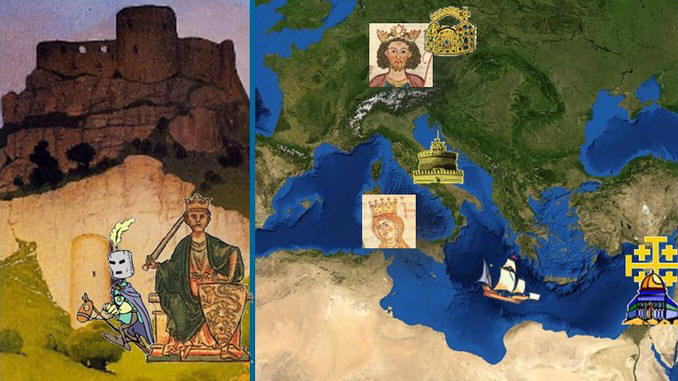
The castle ruins Drachenfels, Löwenburg and Rosenau, Heisterbach Abbey and the ruins of the medieval church on Petersberg remind us of the Middle Ages in the Siebengebirge. It is the time of knights, minnesang, medieval castles and the crusades.
The time of the Ottonian and Salian emperors
in 925, under king Henry the Fowler, the Rhineland became part East Francia. His son Otto I the Great rose to become the most powerful ruler of the Occident. Nonetheless, he had a hard time with the dukes. Therefore, he sought the support of the clergy, the Ottonian Imperial Church system came into being. His brother Bruno was archbishop of Cologne. His daughter-in-law Theophanu is buried in St. Pantaleon, Cologne.
The Salian kings gave us the great imperial cathedrals in Speyer, Worms and Mainz. In Cologne, St. Georg and St. Maria im Kapitol came into being, whose cloverleaf choir soon became a model for other churches in Cologne and the region. The archbishops of Cologne were powerful men in the empire and in our region. In 1118, they built the castle on the Wolkenburg, the first castle in the Siebengebirge.
The time of the Staufer emperors
Frederick Barbarossa, the Red Beard, Henry VI, who hold the crusader Richard the Lionheart in captivity, and finally Frederick II in faraway Puglia. In the Staufer period we encounter the most famous names of the High Middle Ages. It was an eventful time, and our region was devastated by wars.
Despite his numerous campaigns in Italy, Barbarossa’s empire was north of the Alps. This changed already Henry V, under his son and successor. Henry’s mother Beatrix came from Burgundy, his wife Norman wife Constance d’Hauteville brought the Kingdom of Sicily into the marriage. His son Frederick II grew up in Palermo, he loved his homeland. During his reign, southern Italy was the center of his empire, his grandfather’s northern alpine territories came second.

Richard and Otto, uncle and nephew
German and European history met again when Richard the Lionheart was king of England. After a long captivity in Germany, Richard was finally released. However, he had to send hostages, among them his nephew Otto, the son of his sister Matilda Plantagenet and duke Henry the Lion of Brunswick.
Richard and Otto were very close. When the duke was exiled in 1182, he went with his family to the Angevin court. Otto, a boy back then, grew up in the Anglo-Norman culture. His first mother tongue was probably French. Richard was very fond of his nephew, took personally care of his education and later knighted him. Similarly, Otto put all his heart in fighting for Richard against the King of France, Philippe Augustus.
Otto IV, the Angevin on the throne
After the sudden death of emperor Henry VI 1197, the majority of the German princes elected his younger brother Philip of Swabia. However, a minority group of princes around the Archbishop of Cologne did not want another Hohenstaufen ruler. So, the Archbishop searched for another candidate. Now Richard suggested Otto as candidate for the throne. He loved his nephew and wanted the best for him, and he had certainly not forgotten his imprisonment in Germany.
While the Hohenstaufen emperors represented the medieval empire’s glory, Otto had an undeserved bad press for a long time. Yet, he was a bright man and a brave, capable warrior, after all Richard the Lionheart had taught him. Unlike his father or the Hohenstaufen emperors, he did not give orders to destroy entire cities to punish them for rebellion.
Otto has a special place in the chapter on the Middle Ages in the Siebengebirge because the Counts of Sayn on Löwenburg Castle stood firmly by his side.
A look beyond the Rhineland
After years of anarchy, Empress Matilda’s son with Geoffrey ascended the English throne as Henry II. Now here we have the political map of Europe at the time of the Hohenstaufen dynasty. In southern Italy and Sicily, the Normans had established their kingdom. France was controversial. King Louis in Paris only ruled over the Île-de-France and the bordering territories. Most of western France, however, belonged to the Anglo-Norman Plantagenets (Angevin Empire, 1154-1214), King Henry II of England and his wife Alienor of Aquitaine and their son Richard I Lionheart.
It was Holy Roman emperor Henry VI who held Richard captive for a long time. He only released him when Richard’s mother Alienor of Aquitaine delivered the enormous ransom. Richard also had to send hostages, among them was his nephew Otto, later king Otto IV. Yet, Richard had impressed the German nobility. Cologne welcomed mother and son with great celebrations and accompanied them to England. From now on, the city of Cologne maintained good relations with England and enjoyed trade privileges.
Late Middle Ages
There is a lot to report and above all to see.from the late Middle Ages in the Siebengebirge as well. Large parts of Cologne Cathedral were built with stones from Mount Drachenfels; the coats of arms of the Siebengebirge towns Bad Honnef and Königswinter date back to the reigns of those times.

Be the first to comment